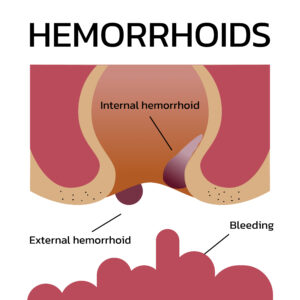
Have you heard about hemorrhoid embolization? This is one of the newest, an dleadt invasive, ways to treat internal hemorrhoids. But what are internal hemorrhoids, who do they affect, and why is HE such an effective treatment? Keep reading to find out!
Internal hemorrhoids are swollen blood vessels that form inside the rectum. Typically, they're the result of pressure due to constipation or straining to pass bowel movements. Symptoms of internal hemorrhoids include bleeding when you pass stool along with itching and mild discomfort.
We classify these hemorrhoids based on the severity of symptoms, using a scale that runs between grades 1 and 4. While discomfort may not be your first symptom, you're quite likely to learn you have internal hemorrhoids after noticing blood spots on your toilet paper or in your toilet bowl.
If you have Grade 1 (or mild) hemorrhoids, simple changes, like increasing your water and fiber intake can usually offer relief. However, if you have grade 2, 3 or 4 hemorrhoids, you will likely need to seek medical interventions. Previously, your best option would have been surgical treatment. However, as of 10 years ago, there's a new treatment option in town: hemorrhoid embolization. And, according to research, this minimally invasive treatment option provides equal or better results than surgical removal of hemorrhoids. Plus, the recovery period is shorter and easier, and there's a lower likelihood of complications.
Internal hemorrhoids involve your Corpus Cavernosum Recti (CCR) network of veins and arteries. For that reason, if we reduce CCR blood flow with embolization, we can also reduce the pain, pressure, itching and bleeding associated with internal hemorrhoids.
What should you expect during your embolization? First, our interventional radiologists insert a small catheter through your wrist or groin. Using this tiny access point, we then guide that catheter to blood vessels in the rectum with the help of X-ray imaging. Once in place, we can then implant small coils in those blood vessels, reducing the flow of blood and your symptoms of internal hemorrhoids. Just about 45 minutes later, you'll be ready to go, returning to work the next day and avoiding an overnight hospital stay.
While hemorrhoid embolization only developed 10 years ago, results regarding its efficacy are promising. One 2016 study followed 40 French patients with grade 1 to 3 internal hemorrhoids; one month after their embolizations, none had experienced post-procedural complications, and 94% of participants achieved relief.
By 2018, a more recent study followed checked in with 25 grade 2 and 3 internal hemorrhoid patients, one year after they had hemorrhoid embolizations. Again, none of the patients experienced post-procedural complications. And 78% of them were still symptom-free and enjoying lasting relief from hemorrhoids.
While hemorrhoid embolization is safe and effective, it's only recommended for patients with grade 2 or 3 internal hemorrhoids. Before coming to our Georgia Hemorrhoid institute, try lifestyle changes to see if they can provide relief. Then, if you still experience the pain, itching and bleeding of internal hemorrhoids, come and schedule a consult with our interventional radiologists!

Atlanta
3225 Cumberland Blvd. Southeast, Suite 520
Atlanta, GA 30339
Stockbridge
1035 Southcrest Dr., Suite 220 + 250
Stockbridge, GA 30281
Tucker
1975 Lakeside Pkwy., Suite 300
Tucker, GA 30084
Scheduling
Please contact our dedicated specialists to schedule a consultation today.
2025 Georgia Hemorrhoid Institute. All rights reserved. Website Design by Healthcare Success